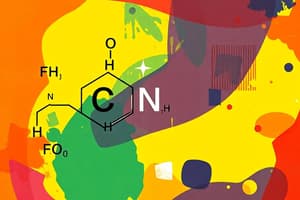Podcast
Questions and Answers
What is stereochemistry and what does it focus on?
What is stereochemistry and what does it focus on?
Stereochemistry is the study of the relative spatial arrangement of atoms in molecules and their manipulation. It focuses on the relationships between stereoisomers, which have the same molecular formula and sequence of bonded atoms but differ in the geometric positioning of the atoms in space.
What does the prefix 'stereo-' mean in 'stereochemistry'?
What does the prefix 'stereo-' mean in 'stereochemistry'?
The prefix 'stereo-' means 'three-dimensionality'.
When were stereochemical principles developed and who made the initial observation leading to their development?
When were stereochemical principles developed and who made the initial observation leading to their development?
Stereochemical principles were developed after the observations of certain molecular phenomena. In 1815, Jean-Baptiste Biot's observation of optical activity marked the beginning of organic stereochemistry history.
In what areas does stereochemistry span?
In what areas does stereochemistry span?
What did Jean-Baptiste Biot observe in 1815 that marked the beginning of organic stereochemistry history?
What did Jean-Baptiste Biot observe in 1815 that marked the beginning of organic stereochemistry history?
What is the purpose of a structural formula in chemistry?
What is the purpose of a structural formula in chemistry?
What is the significance of using structural formulas for describing chemical compounds?
What is the significance of using structural formulas for describing chemical compounds?
What are some of the different types of structural formulas that can be used to represent chemical compounds?
What are some of the different types of structural formulas that can be used to represent chemical compounds?
What are some systematic chemical naming formats that are equivalent to geometric structures?
What are some systematic chemical naming formats that are equivalent to geometric structures?
Why do chemists typically describe chemical reactions or synthesis using structural formulas instead of chemical names?
Why do chemists typically describe chemical reactions or synthesis using structural formulas instead of chemical names?
Flashcards are hidden until you start studying




